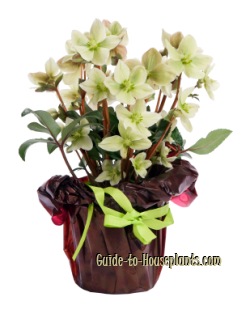





Botanical Name: Helleborus niger
White hellebore is a winter-bloomer that has emerged as a popular house plant for the holiday season. Often called Christmas Rose, flowers bloom from winter through spring.
This hellebore plant is sold by florists already in bloom before the holidays, which makes it a festive decoration. However, you'll likely see this Christmas Rose flower later in the season in subsequent years -- probably between January and April.
Flowers are held singly on upright, thick stems and open flat. Some new hybrids have a starry shape, while many have rounded petals. Thick, shiny evergreen leaves make this plant attractive year-round.
Hellebores have brittle roots and don't like to be moved around. If you move it outdoors, find a spot in your shade garden or near a pathway where you'll see its enchanting flowers while the rest of the garden is still asleep.
Native to mountain regions of Europe, this evergreen thrives with cool temps and low light levels. If you live in U.S. Zone 4, you can move your potted plant outdoors after blooming is over. Plant it in your shade garden with well-drained soil and you'll enjoy this perennial for many years.
To repot...or not. Repot white hellebore when you see roots at the soil surface or coming out the drainage holes. Wait till spring to repot -- never while it's blooming. Use a pot with drainage holes to prevent soggy soil.
Is Hellebore niger poisonous? Oh, yes. Keep your indoor plant away from young children and pets. You'll also want to wear gloves when handling it because this beautiful bloomer may cause skin irritation. The good news is that if you plant it outdoors, deer won't touch it.

Origin: Mountainous regions of Europe, including Switzerland, southern Germany, Austria and northern Italy.
Height: Up to 1 ft (30 cm)
Light: Put your potted hellebore plant where it will get partial or filtered sunlight. Indirect morning sun and afternoon shade will suit it fine.
Water: Keep the soil evenly moist while hellebore is growing and flowering. Water less after flowering is finished. Yellow leaves are caused by overwatering.
Humidity: Average room humidity
Temperature: Cool to average 45-65°F/7-18°C
Soil: Neutral pH to alkaline potting mix
Fertilizer: Feed monthly year-round with a balanced liquid fertilizer diluted by half.
Propagation: Divide plants in early spring, shortly after flowering is over. Handle its fragile roots with care.
Copyright © www.100flowers.win Botanic Garden All Rights Reserved